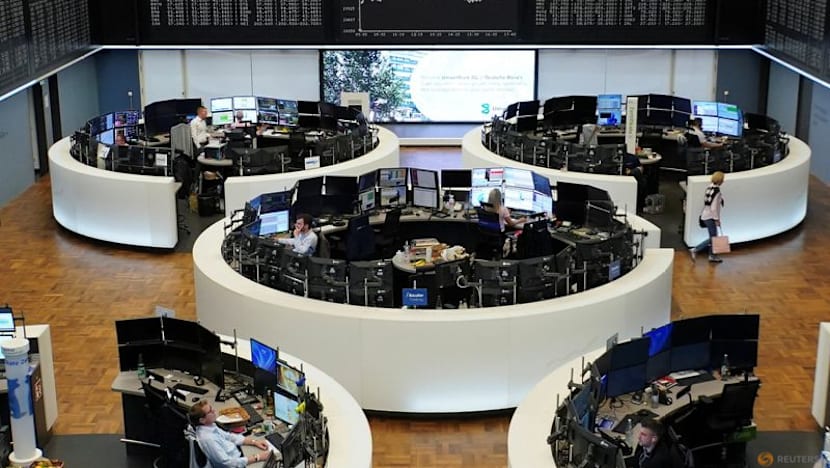Business
Stocks Stabilize as Dollar Drops Following Trump’s Visa Restrictions

Global stock markets showed signs of stabilization, with MSCI’s global stock index inching upward while the U.S. dollar experienced a decline. This shift occurred as investors assessed President Donald Trump‘s recent announcement regarding new visa restrictions and awaited commentary from officials at the Federal Reserve.
On March 15, 2024, Trump declared that U.S. companies would be required to pay $100,000 for new H-1B worker visas. This measure poses a significant challenge for the U.S. technology sector, which heavily relies on skilled labor from abroad. Following this announcement, India’s benchmark indexes fell, reflecting concerns about the potential impact on its $283 billion information technology sector, which derives more than half of its revenue from the U.S.
Investor sentiment was also influenced by Trump’s recent decision to double tariffs on imports from India to as high as 50 percent. This action was partly attributed to New Delhi’s ongoing purchases of Russian oil. As a result, Wall Street indexes remained close to flat after reaching record closing highs the previous week.
“It’s not unusual to see some market weakness following all-time highs,” said Carol Schleif, Chief Market Strategist at BMO Private Wealth Management. She noted that the upcoming trading week could be volatile due to anticipated remarks from Federal Reserve officials, including Chair Jerome Powell, and the release of key inflation data.
St. Louis Fed President Alberto Musalem expressed concern about the limits for further rate cuts, given that inflation remains above the Fed’s 2 percent target. Similarly, Atlanta Fed President Raphael Bostic indicated in a recent interview with the Wall Street Journal that he does not foresee the need for additional interest rate cuts this year.
Concerns about the implications of Trump’s visa policy were palpable among investors. Despite this uncertainty, the S&P 500 technology sector managed a slight gain. Schleif suggested that many tech CEOs likely maintain close communication with Trump to seek possible solutions to navigate the new regulations.
As trading commenced on Wall Street, all three major indexes opened lower. By 10:48 a.m., the Dow Jones Industrial Average had fallen 6.27 points, or 0.01 percent, to 46,309.00. In contrast, the S&P 500 rose 9.65 points, or 0.14 percent, to 6,674.01, while the Nasdaq Composite increased 67.28 points, or 0.30 percent, to 22,698.20. The MSCI gauge of stocks worldwide rose by 1.04 points, or 0.11 percent, to 982.79.
In the currency markets, the U.S. dollar index aimed to end a three-day winning streak as investors anticipated comments from the Federal Reserve to clarify the monetary policy outlook following a 25 basis points rate cut. The dollar index, which measures the greenback against a basket of currencies, fell 0.23 percent to 97.50. The euro appreciated by 0.21 percent to $1.1769, while the dollar weakened by 0.03 percent against the Japanese yen, trading at 147.9.
Meanwhile, Argentina’s international dollar bonds experienced a rally following comments from U.S. Treasury Secretary Scott Bessent, who stated that “all options for stabilization are on the table” to support Argentina. More details are expected after Argentine President Javier Milei meets with Trump on Tuesday in New York.
In the realm of U.S. Treasuries, the yield on benchmark U.S. 10-year notes dropped by 0.4 basis points to 4.135 percent, down from 4.139 percent late on Friday. Conversely, the yield on the 30-year bond rose by 0.5 basis points to 4.7615 percent. The 2-year note yield, which often aligns with interest rate expectations for the Federal Reserve, increased by 0.2 basis points to 3.584 percent.
In energy markets, oil prices declined as concerns regarding supply from Russia and the Middle East clashed with oversupply fears. U.S. crude dropped 0.4 percent to $62.43 a barrel, while Brent crude fell 0.45 percent to $66.38 per barrel.
In contrast, precious metals saw a significant rise, with gold prices reaching new record highs. Spot gold increased by 0.99 percent to $3,720.18 an ounce, while U.S. gold futures rose 1.34 percent to $3,720.80 an ounce, driven by investor expectations for a dovish monetary policy following the anticipated remarks from Federal Reserve officials and forthcoming inflation data.
-

 Lifestyle4 months ago
Lifestyle4 months agoHumanism Camp Engages 250 Youths in Summer Fest 2025
-

 Business5 months ago
Business5 months agoKenvue Dismisses CEO Thibaut Mongon as Strategic Review Advances
-

 Sports4 months ago
Sports4 months agoDe Minaur Triumphs at Washington Open After Thrilling Comeback
-

 Sports5 months ago
Sports5 months agoTupou and Daugunu Join First Nations Squad for Lions Clash
-

 Top Stories5 months ago
Top Stories5 months agoColombian Senator Miguel Uribe Shows Signs of Recovery After Attack
-

 World5 months ago
World5 months agoASEAN Gears Up for Historic Joint Meeting of Foreign and Economic Ministers
-

 Health4 months ago
Health4 months agoNew Study Challenges Assumptions About Aging and Inflammation
-

 Business5 months ago
Business5 months agoOil Prices Surge Following New EU Sanctions on Russia
-

 Entertainment4 months ago
Entertainment4 months agoDetaşe-Sabah Violin Ensemble Captivates at Gabala Music Festival
-

 Entertainment4 months ago
Entertainment4 months agoBaku Metro Extends Hours for Justin Timberlake Concert
-

 Top Stories5 months ago
Top Stories5 months agoRethinking Singapore’s F&B Regulations Amid Business Closures
-

 Business5 months ago
Business5 months agoU.S. House Approves Stablecoin Bill, Sends to Trump for Signature









